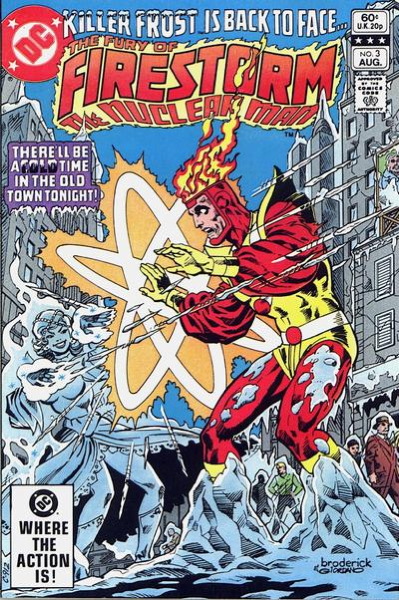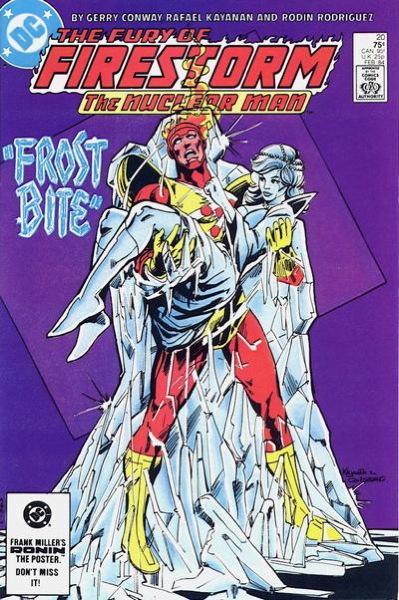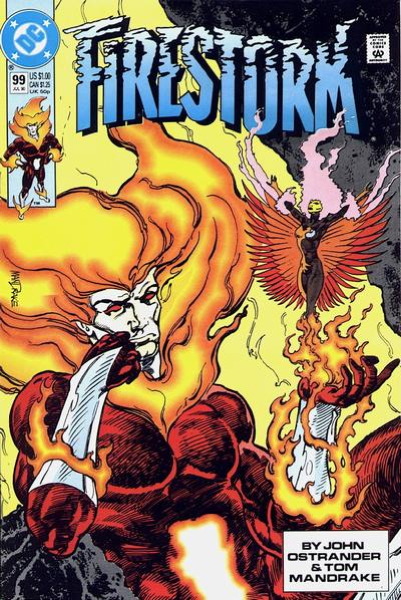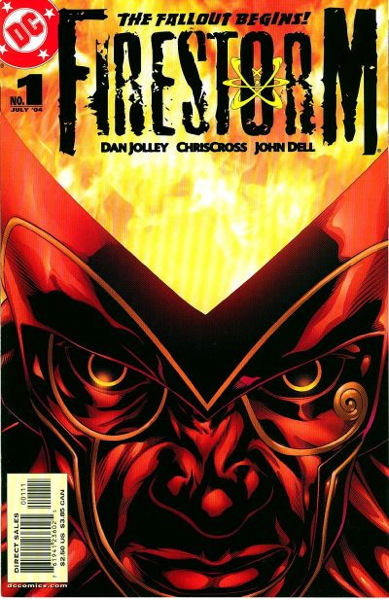Remember that trend of naming characters “[Something] The [Something Else] Man?” They should bring that back.
Jay from Tennessee volunteers the following
“What was it that you liked most about Firestorm?”
Let’s borrow Mr. Peabody’s WayBack Machine and travel back to the joyous, nigh-utopian days of 2007 when I wrote a bit about my Firestorm fandom:
Me: “You know what I like about Firestorm?”
Employee Aaron: “No, what?”
Me: “Well, Ron Raymond [Firestorm’s secret identity — well, one of them] is on the school’s basketball team, and he’s always getting picked on by the school brain, Cliff Carmichael. It’s some kind of weird parallel universe high school where the jocks get bullied by the smart guys.”
Aaron: “So what parallel Earth would that be?”
Me: “I’d call it ‘Earth-Remarkably-Improbable.’”
Okay, that’s a little facetious (what, on this blog? NOOOOO) but…you know, I was trying to think if I’d encountered Firestorm much prior to the launch of the 1982 series. I’ve read some Justice League of America before that, so I definitely c him there, and there were a handful of back-ups in Flash that I know I read. But at this point in time, I can’t recall if the character really grabbed my attention or if he just happened to be a dude in a comic I was reading for other reasons.
I suppose I must have liked him well enough to drop my two quarters and a dime on the first issue when it was released. I think a lot of it had to do with being an excited 11 to 13-year-old getting in on the ground floor of all these new comics that were popping up (like Saga of the Swamp Thing, natch, and All-Star Squadron, just to name a couple).
And like I said in my 2007 excerpt up there, I liked the weird premise of Firestorm actually being two people who would merge together into one shared-body superhero, with the impulsive teen (Ronnie) controlling the body and the older scientist (Martin) as the voice in his head. The additional twist of that “voice” being represented by Martin’s ghostly “head” that only we, the readers, and Ronnie could see was a clever one.
Another plus was the artwork, which remains my favorite example of Pat Broderick’s work to this day:

Even after doing this blog for nearly two decades I’m still not any better at describing art much beyond “pictures good,” but, hey, you know, pictures good. There was a detail, a graininess, to his work that felt…unusual to me at the time, which you didn’t see much in the usually much slicker superhero comics. Even when Broderick left regular penciling duties and was replaced by Rafael Kayanan:

…the artwork was still somewhat Of A Kind with what had come before. A little slicker, maybe, but still evoked Broderick’s influence in a way that later artists on the title would leave behind.
I enjoyed the stories as well, particularly the difficulties superhero-ing placed on Ronnie and Martin’s personal lives (especially Martin, who initially didn’t retain memory of his time as half of Firestorm). And of course the whole business with Ronnie’s rivalry with Cliff Carmichael, as mentioned above. It was all presented with just the right mix of humor, melodrama, and action, and always felt like I got my money’s worth out of each issue. I realize in hindsight it’s all very Spider-Man, almost certainly intentionally, but for a kid who hadn’t read many of those Spideys, and certainly not from the beginning, this all seemed fresh and enthralling to me.
Okay, with all this “from the beginning” talk I should note that I was aware at the time there was a previous Firestorm series in the ’70s. Certainly that they named the title Fury of Firestorm to differentiate itself from the previous Firestorm I do remember noting back then (in the same way Saga of the Swamp Thing was so named as to avoid confusion with Swamp Thing.) This, amongst other quests, is what would eventually lead me to comic shops looking for back issues. I eventually got that first series, though oddly I never sought out the Flash back-ups I didn’t have. Ah well, I eventually bought the book, so that’s moot now.
Once or twice on this site I believe I’ve mentioned that I really enjoyed the beginning of Fury of Firestorm and the end of it, while kinda coasting along through the middle which wasn’t…well, let’s say it was a little more inconsistent. Not necessarily bad, but not always to my taste either. However, I was still invested in the characters and wanted to see what happened with them. Yes, even Cliff Carmichael.
This is, unsurprisingly, going on forever, so let me try to wrap things up a bit. I did like how they changed things up and did things like replace Martin with another guy in the Firestorm merger, and went through a period where Firestorm himself had his own personality separate from the two men who’d form him.
Most notably, there was that business where, “inspired” by Swamp Thing’s journey into discovering he was a Plant Elemental, formed by Earth to be its champion, so was Firestorm sent on his own journey to become a Fire Elemental in much the same way. Oh, and said journey came with his own knock-off of John Constantine. Yeah, I know. But this all brought us to a new, relatively short-lived redesign for the character and some dynamic artwork from Tom Mandrake:

And then after this there were additional revivals/revamps of the character, specifically with new kid Jason taking over the role:

…in a fun series that provided a new take on the premise, while still following up on characters and events from the previous series. Of note: the end of DC’s Brightest Day event included an epilogue that threatened a dire fate for Firestorm that clearly was going to lead into…something, but that (and other set-ups from the end of this series) were cut down a’bornin’ with the advent of the New 52 publishing initiative. That to me was a major clue (along with what appeared to be poor, rushed planning overall) the New 52 was as much a surprise to DC as it was to the rest of us.
Anyway, Jay, I realize a lot of that was more “here’s a history of Firestorm” more than “what I liked about Firestorm,” but all these twists and turns in the character’s timeline always kept me interested. Until the cut-off and relaunch with the New 52, you could drawn a line from those beginnings as a 1970s series canceled early due to the DC Implosion, to all those Brightest Day shenanigans. I enjoyed being able to follow the lives of these characters for so long, and though their original story didn’t end so much as stop, as is often the case in superhero comics, the ride was of course all the fun.
I will say that the reveal of Martin Stein as a bad guy in Doomsday Clock was not my favorite thing. Who knows if DC’s “Infinite Frontier” initiative takes care of that or not. IT BETTER.








Lovely recap and seconded on the broderick art. i loved the crossovers with captain atom at the time too. for me the appeal was much simpler – i loved (and still love) the heck out that costume – no single detail standa out as a fave: the red/yellow combo, the puffy sleeves and long gloves, the off-centre logo, the freakin flaming hair… dude was a dynamic looking hero and flamboyant under most people’s pen. also the whole transformation powers schtick with the dash of pseudochemistry was pretty cool.
heh. i gush. guess i like the guy.
i also liked that one moment of the very first transformation that showed us Stormy all in the buff before ronny whipped up the costume. that was a nice detail.
My understanding of DOOMSDAY CLOCK is that it got so late that it got significantly outpaced by the rest of the DC Universe (as plans kept changing). Similar to the BRIGHTEST DAY situation, except it became irrelevant before it even finished publishing.
Has anything from that series been referenced at all since ?
I’m so thankful to have my first letter to the editor published here, only about forty years into comics. :) I had no idea about the character’s progression into the 1980’s and all the twists and turns. I was crushed–crushed–by the first series cancellation and somehow (despite being a Flash fan back in the day) never saw Firestorm in those issues. I’ve got some reading to do. :)
Hello Mike, were you aware at the time of what Cliff Carmichael was up to in Suicide Squad? He was a real piece of work, I tell you!
Firestorm was one of the few DC superhero comics you could buy at the newsstand in Australia in the 80s (your Batmans, Superman, justice leagues, Titans and the like were published under a local licence as sporadic bw 80pg collections) firestorm was probably the most marvel-like of the superhero comics DC were producing pre-crisis as well. I loved Broderick as Micronauts was one of my favourite titles, the costume and the flaming head were cool as hell and he had a pretty top-notch rogues gallery to boot.
I remember a mild controversy in fannish circles about the first issue of the original Firestorm series, because the character’s origin depended on anti-nuclear power activists planting a big bomb in a reactor. This was despite the fact that actual protests against nuclear power–very much a thing in the real world at the time–were pretty much entirely peaceful.
Of course, this was consistent with the way comics presented protest in the 1960s and ’70s. It was always shown as wrong, without exception, and always led to criminal acts in which innocent people were injured.
The type of protestor most likely to be presented as dead wrong was any Black man arguing that the system was racist and that his people could no longer wait for white people to do the right thing. Any such character could count on a stern lecture from the (always white) hero, who might admit that maybe things are not perfect just now, but any attempt to change them that went beyond writing a stern letter to one’s congressman was wrong, both morally and tactically (because, you know, it was certain to lead to criminal acts in which innocent people would be injured–and, if the Black man was so foolish as to ignore the hero’s advice, then the innocent person injured would always be someone close to him).
I note that I am basing this summary not only on old memories but on recent re-readings, in case anyone doubts its accuracy.
Actually, now that I have thought a bit more, I can think of one instance when a comics writer of that period accepted that maybe Black people could be justified in fighting back against oppression.
This was in a short-lived Marvel Western series, THE GUNHAWKS, written by Gary Friedrich. One of the heroes was an ex-slave, and he was originally presented as a defender of slavery. No, really. Slavery, he said (angrily, in response to a white man who presumed that he was glad it had been abolished), was a perfectly good thing as long as one had a good master. Abolishing it just led to all sorts of trouble.
Apparently, Friedrich got some push-back on this, and in a later issue he had this character admit that maybe slavery was wrong, after all. However, he put the blame for it on more on the slaves than the slavers. After all, he said, if slavery was really intolerable, then the slaves should have risen up and fought against it.
One might dismiss this merely with an observation that Friedrich had his issues, but really, he was not so far off from the other writers at Marvel and DC at the time. On other issues some of these writers were perhaps willing to concede that protesters had a point (if they were absolutely wrong in their methods), but the writers were in unison about the civil rights movement: It absolutely had to reject any form of violence whatsoever, and devote itself exclusively to winning white hearts and minds. This is perhaps not an objectively terrible position (the first half, anyway, was that of Dr. King), but the absolute abhorrence with which the white writers treated any Black man who did not agree indicates that the writers (all white, I am pretty sure) were motivated more by fear than a devotion to pacifism. Clearly, they did not like the thought of what happen to THEM if there was an actual revolution.
Gary Friedrich wrote a story-arc in Daredevil, based on the Chicago Seven, where a Right-Wing judge was hiring thugs to plant bombs and then blame the violence on the protestors.
I thought that was a pretty good story.
He also wrote a story in one of the last issues of the early-‘70s Nick Fury series featuring the Super-Patriot, who wanted to end immigration to America.
I did read the short-lived Gunhawks series, and I don’t remember that aspect to Reno Jones.
I remember a story where the two came upon a plantation where they were still using slave-labour, and Reno led a slave rebellion where the Colonel was killed.
Another issue featured the two coming upon Union army soldiers planning to massacre a Cheyenne village. Reno tried to warn the Native American people, but it was too late.
IF Friedrich did write such idiocy in the Gunhawks at some point, I might blame it on the fact that Friedrich was an alcoholic at the time, and later admitted that he turned in scripts that he had written while drunk and was ashamed of his writing (I mostly have heard him give those thoughts about his work on the Johnny Blaze-Ghost Rider though).
Some of the writers of the day came from the counter-culture or New Left movement….Steven Englehart, Steve Gerber, Denny O’Neil (he was a member of the Catholic Workers movement during his youth)…
Also, there’s the classic Don McGregor run on Black Panther, where the Black Panther fights the Ku Klux Klan.
I only read the John Ostrander Firestorm. I understand it was not well-regarded by many Firestorm fans at the time (between his Firestorm & Suicide Squad stories he wiped out most of the rogue’s gallery), but I enjoyed those issues quite a lot.
To me, Cliff Carmichael is the Thinker — full stop. I was happy the character was left alive long enough for Ostrander to write his death scene.
I loved Firestorm, though I bought most of the series as back issues. I think part of the appeal was the great art by Broderick & Kayanan, and that Gerry Conway was given creative freedom to do what he wanted with one of his creations for approx. 50 issues.
I myself became a Firestorm fan through the Challenge of the Super Friends cartoon. He was just so cool looking. And, of course, I had to get the Super Powers action figure. Looking back, it’s kind of crazy that producers picked Firestorm of all people to add to that cartoon (alongside the more obvious Cyborg) to appeal to kids.
“Also, there’s the classic Don McGregor run on Black Panther, where the Black Panther fights the Ku Klux Klan.”
And this was brought about by an editor wanting more white people in the comic! HA!
That second Firestorm series whose ending you enjoyed was basically killed by two things: that ugly new Mandrake costume and a revision to the power set — the character just became another guy who sets things on fire, of the sort we’ve seen plenty of before.
A shame, because until then John Ostrander had been on such a good run writing the character.